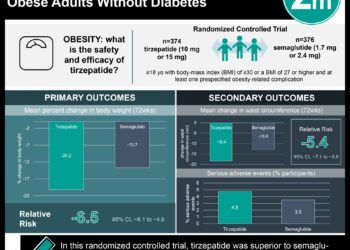Active commuting associated with a lower BMI, body fat
1. Commuting via public transportation, walking, or cycling was associated with a lower body mass index and body fat percentage, compared to commuting via private motorized vehicle.
Evidence Rating Level: 2 (Good)
Study Rundown: The health benefits of physical activity are clear, and recent evidence suggests that engaging in physically active commutes is associated with overall higher individual physical activity levels. Active commuters self-report lower rates of being overweight, but limited data are available evaluating objective obesity measures in individuals whose commutes are physically active versus predominantly sedentary. In this population-based cross-sectional study in the U.K., it was found that people who primarily walk or cycle during their commute and people who use public transportation to commute had similar, significant decreases in levels of body mass index and body fat percentage, even after adjustment for potential confounding factors such as age, presence of limiting illness or disability, socioeconomic status, and level of physical activity in the workplace. These data provide evidence to support the obesity benefits of incorporating greater levels of physical activity into the daily commute, and encourage policy-level promotion of public transportation as a viable public health option for increasing daily physical activity levels.
The robust data source from which these results were obtained improves the generalizability of the results and is a strength of this study. However, the cross-sectional study design limits discussion of causality in the link between activity level of commute and markers of obesity. Residual confounding by less robustly measured variables, such as dietary information, has the potential to attenuate the associations observed. Nevertheless, these data provide evidence that engaging in more physically active daily commutes is related to lower levels of obesity.
Click to read the study, published today in the BMJ
Click to read an accompanying editorial in the BMJ
Relevant Reading: Active travel to work and cardiovascular risk factors in the United Kingdom
In-Depth [cross-sectional study]: This study evaluated the association between level of physical activity during commute and objective markers of obesity. Participants included 7,534 men and women living in the United Kingdom who had participated in the UK Household Longitudinal Study. A descriptive analysis was undertaken to compare the prevalence of different modes of commute – private motorized transport, public transport, and active transport including walking or cycling – as well as body mass index and body fat percentage in the sample. Multivariate linear regression was used to evaluate the association between commute type as exposure and obesity measures as outcome, with adjustment for potential confounders including age, presence of limiting illness or disability, socioeconomic status, level of physical activity in the workplace, participation in recreational sports, among others. Private transport was used by 76% of men and 72% of women. Public transport was used by 10% of men and 11% of women while 14% of men and 17% of women walked or cycled to work. Men who commuted via public transport had BMI levels 1.43 (CI95% 0.84-2.01) points lower than those who commuted via private transport. BMI in men who used active transport was 1.41 (CI95% 0.85-1.97) points lower than those who used private transport. Adjustment for all confounders attenuated the magnitude of BMI reduction, to 1.05 (CI95% 0.49-1.61) and 1.01 (CI95% 0.45-1.57), respectively. Similar patterns of BMI reduction were observed in women, with BMI levels 0.94 (CI95% 0.26-1.62) points lower in active commuters and 0.86 (CI95% 0.36-1.35) points lower in public transport users, compared to those who commute via private transport in unadjusted models.
More from this author: Risk of cerebral palsy linked with relatedness to cerebral palsy patient
Image: PD
©2012-2014 2minutemedicine.com. All rights reserved. No works may be reproduced without expressed written consent from 2minutemedicine.com. Disclaimer: We present factual information directly from peer reviewed medical journals. No post should be construed as medical advice and is not intended as such by the authors, editors, staff or by 2minutemedicine.com. PLEASE SEE A HEALTHCARE PROVIDER IN YOUR AREA IF YOU SEEK MEDICAL ADVICE OF ANY SORT.







